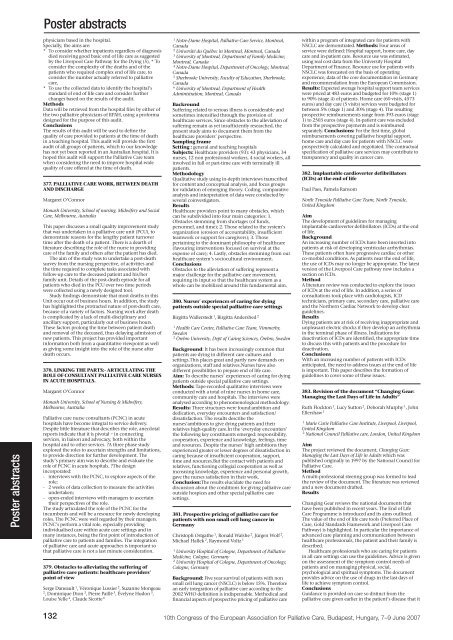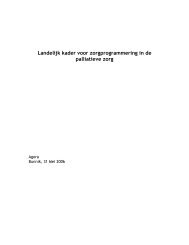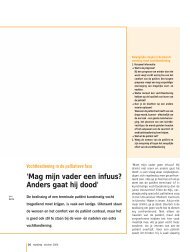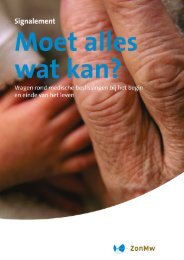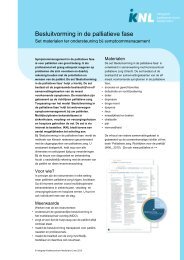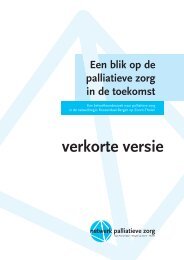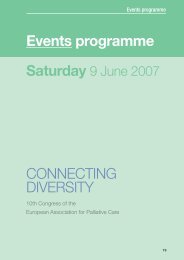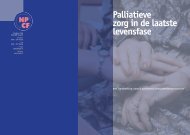Poster abstracts CONNECTING DIVERSITY
Poster abstracts CONNECTING DIVERSITY
Poster abstracts CONNECTING DIVERSITY
You also want an ePaper? Increase the reach of your titles
YUMPU automatically turns print PDFs into web optimized ePapers that Google loves.
<strong>Poster</strong> <strong>abstracts</strong><br />
<strong>Poster</strong> <strong>abstracts</strong><br />
physicians based in the hospital.<br />
Specially, the aims are:<br />
* To consider whether inpatients regardless of diagnosis<br />
died receiving good basic end of life care as suggested<br />
by the Liverpool Care Pathway for the Dying (5), * To<br />
consider the complexity of the deaths and of the<br />
patients who required complex end of life care, to<br />
consider the number actually referred to palliative<br />
care,<br />
* To use the collected data to identify the hospital’s<br />
standard of end of life care and consider further<br />
changes based on the results of the audit.<br />
Methods<br />
Data will be retrieved from the hospital files by either of<br />
the two palliative physicians of RPAH, using a proforma<br />
designed for the purpose of this audit.<br />
Conclusions<br />
The results of this audit will be used to define the<br />
quality of care provided to patients at the time of death<br />
in a teaching hospital. This audit will provide the first<br />
audit of all groups of patients, which to our knowledge<br />
has not yet been reported in an Australian hospital. It is<br />
hoped this audit will support the Palliative Care team<br />
when considering the need to improve hospital-wide<br />
quality of care offered at the time of death.<br />
377. PALLIATIVE CARE WORK, BETWEEN DEATH<br />
AND DISCHARGE<br />
Margaret O’Connor<br />
Monash University, School of nursing, Midwifery and Social<br />
Care, Melbourne, Australia<br />
This paper discusses a small quality improvement study<br />
that was undertaken in a palliative care unit (PCU), to<br />
demonstrate reasons for the lengthy patient turnover<br />
time after the death of a patient. There is a dearth of<br />
literature describing the role of the nurse in providing<br />
care of the family and others after the patient has died.<br />
The aim of the study was to undertake a post-death<br />
survey from the nursing perspective, of activities and<br />
the time required to complete tasks associated with<br />
follow-up care to the deceased patient and his/her<br />
family unit. Details of the post-death episode for all<br />
patients who died in the PCU over two time periods<br />
were collected using a newly designed tool.<br />
Study findings demonstrate that most deaths in this<br />
Unit occur out of business hours. In addition, the study<br />
has highlighted the protracted nature of post-death care,<br />
because of a variety of factors. Nursing work after death<br />
is complicated by a lack of multi-disciplinary and<br />
ancillary support, particularly out of business hours.<br />
These factors prolong the time between patient death<br />
and removal of the deceased, thus delaying admission of<br />
new patients. This project has provided important<br />
information both from a quantitative viewpoint as well<br />
as giving some insight into the role of the nurse after<br />
death occurs.<br />
378. LINKING THE PARTS:- ARTICULATING THE<br />
ROLE OF CONSULTANT PALLIATIVE CARE NURSES<br />
IN ACUTE HOSPITALS.<br />
Margaret O’Connor<br />
Monash University, School of Nursing & Midwifery,<br />
Melbourne, Australia<br />
Palliative care nurse consultants (PCNC) in acute<br />
hospitals have become integral to service delivery.<br />
Despite little literature that describes the role, anecdotal<br />
reports indicate that it is pivotal – in connecting<br />
services, in liaison and advocacy, both within the<br />
hospital and to other services. ?A three phase study<br />
explored the roles to ascertain strengths and limitations,<br />
to provide direction for further development. The<br />
study’s primary aim was to describe and evaluate the<br />
role of PCNC in acute hospitals. ?The design<br />
incorporated:<br />
- interviews with the PCNC, to explore aspects of the<br />
role;<br />
- 2 weeks of data collection to measure the activities<br />
undertaken;<br />
- open-ended interviews with managers to ascertain<br />
their perspectives of the role.<br />
The study articulated the role of the PCNC for the<br />
incumbents and will be a resource for newly developing<br />
roles. The PCNC were well regarded by their managers.<br />
PCNC’s perform a vital role, especially providing<br />
individualised care within acute care settings and in<br />
many instances, being the first point of introduction of<br />
palliative care to patients and families. The integration<br />
of palliative care and acute approaches is important so<br />
that palliative care is not a last minute consideration.<br />
379. Obstacles to alleviating the suffering of<br />
palliative care patients: healthcare providers’<br />
point of view<br />
Serge Daneault 1 , Véronique Lussier 2 , Suzanne Mongeau<br />
2<br />
, Dominique Dion 3 , Pierre Paillé 5 , Évelyne Hudon 3 ,<br />
Louise Yelle 4 , Claude Sicotte 6<br />
1<br />
Notre-Dame Hospital, Palliative Care Service, Montreal,<br />
Canada<br />
2<br />
Université du Québec in Montreal, Montreal, Canada<br />
3<br />
University of Montreal, Department of Family Medicine,<br />
Montreal, Canada<br />
4<br />
Notre-Dame Hospital, Department of Oncology, Montreal,<br />
Canada<br />
5<br />
Sherbrooke University, Faculty of Education, Sherbrooke,<br />
Canada<br />
6<br />
University of Montreal, Department of Health<br />
Administration, Montreal, Canada<br />
Backround<br />
Suffering related to serious illness is considerable and<br />
sometimes intensified through the provision of<br />
healthcare services. Since obstacles to the alleviation of<br />
suffering remain as yet insufficiently researched, the<br />
present study aims to document them from the<br />
healthcare providers’ perspective.<br />
Sampling frame<br />
Setting : general and teaching hospitals<br />
Subjects: Healthcare providers (93): 43 physicians, 34<br />
nurses, 12 non professional workers, 4 social workers, all<br />
involved in full or part-time care with terminally ill<br />
patients.<br />
Methodology<br />
Qualitative study using in-depth interviews transcribed<br />
for content and conceptual analysis, and focus groups<br />
for validation of emerging theory. Coding, comparative<br />
analysis and interpretation of data were conducted by<br />
several coinvestigators.<br />
Results<br />
Healthcare providers point to many obstacles, which<br />
can be subdivided into four main categories: 1.<br />
Obstacles stemming from shortages (of funds,<br />
personnel, and time); 2. Those related to the system’s<br />
organization (erosion of accountability, insufficient<br />
teamwork or support for caregivers); 3. Those<br />
pertaining to the dominant philosophy of healthcare<br />
(favouring interventions focused on survival at the<br />
expense of care); 4. Lastly, obstacles stemming from our<br />
healthcare system’s sociocultural environment.<br />
Conclusions<br />
Obstacles to the alleviation of suffering represent a<br />
major challenge for the palliative care movement,<br />
requiring its input so that the healthcare system as a<br />
whole can be mobilized around this fundamental aim.<br />
380. Nurses’ experiences of caring for dying<br />
patients outside special palliative care settings<br />
Birgitta Wallerstedt 1 , Birgitta Andershed 2<br />
1<br />
Health Care Centre, Palliative Care Team, Vimmerby,<br />
Sweden<br />
2<br />
Örebro University, Dept of Caring Sciences, Örebro, Sweden<br />
Background: It has been increasingly common that<br />
patients are dying in different care cultures and<br />
settings.This places great and partly new demands on<br />
organizations, staff and relatives.Nurses have also<br />
different possibilities to prepare end of life care.<br />
Aim: To describe nurses’ experiences of caring for dying<br />
patients outside special palliative care settings.<br />
Methods: Tape-recorded qualitative interviews were<br />
conducted with a total of nine nurses in home care,<br />
community care and hospitals. The interviews were<br />
analysed according to phenomenological methodology.<br />
Results: Three structures were found:ambition and<br />
dedication, everyday encounters and satisfaction/<br />
dissatisfaction. The results describe the<br />
nurses’ambitions to give dying patients and their<br />
relatives high-quality care.In the ‘everyday encounters’<br />
the following key constituents emerged: responsibility,<br />
cooperation, experience and knowledge, feelings, time<br />
and resources. Despite the nurses’ high ambitions they<br />
experienced greater or lesser degrees of dissatisfaction in<br />
caring because of insufficient cooperation, support,<br />
time and resources.But the contact with patients and<br />
relatives, functioning collegial cooperation as well as<br />
increasing knowledge, experience and personal growth,<br />
gave the nurses satisfaction in their work.<br />
Conclusion:The results elucidate the need for<br />
discussion about the conditions for giving palliative care<br />
outside hospices and other special palliative care<br />
settings.<br />
381. Prospective pricing of palliative care for<br />
patients with non small cell lung cancer in<br />
Germany<br />
Christoph Ostgathe 1 , Ronald Walshe 2 , Jürgen Wolf 2 ,<br />
Michael Hallek 2 , Raymond Voltz 1<br />
1<br />
University Hospital of Cologne, Department of Palliative<br />
Medicine, Cologne, Germany<br />
2<br />
University Hospital of Cologne, Department of Oncology,<br />
Cologne, Germany<br />
Background: Five year survival of patients with non<br />
small cell lung cancer (NSCLC) is below 15%. Therefore<br />
an early integration of palliative care according to the<br />
2002 WHO definition is indispensable. Methodical and<br />
financial aspects of prospective pricing of palliative care<br />
within a program of integrated care for patients with<br />
NSCLC are demonstrated. Methods: Four areas of<br />
service were defined: Hospital support, home care, day<br />
care and in-patient care. Resource use was estimated,<br />
using real cost data from the University Hospital<br />
Department of Finance. Resource use for patients with<br />
NSCLC was forecasted on the basis of operating<br />
experience, data of the core documentation in Germany<br />
and recommendation from the European Commission.<br />
Results: Expected average hospital support team services<br />
were priced at 483 euros and budgeted for 10% (stage 1)<br />
to 90% (stage 4) of patients. Home care (60 visits, 4573<br />
euros) and day care (5 visits) services were budgeted for<br />
between 5% (stage 1) and 30% (stage 4). The resulting<br />
prospective reimbursements range from 393 euros (stage<br />
1) to 2503 euros (stage 4). In-patient care was excluded<br />
from the prospective payments and is reimbursed<br />
separately. Conclusions: For the first time, global<br />
reimbursements covering palliative hospital support,<br />
home care and day care for patients with NSCLC were<br />
prospectively calculated and negotiated. The contractual<br />
specification of palliative care services may contribute to<br />
transparency and quality in cancer care.<br />
382. Implantable cardioverter defibrillators<br />
(ICDs) at the end of life<br />
Paul Paes, Pamela Ransom<br />
North Tyneside Palliative Care Team, North Tyneside,<br />
United Kingdom<br />
Aim<br />
The development of guidelines for managing<br />
implantable cardioverter defibrillators (ICDs) at the end<br />
of life.<br />
Background<br />
An increasing number of ICDs have been inserted into<br />
patients at risk of developing ventricular arrhythmias.<br />
These patients often have progressive cardiac or other<br />
co-morbid conditions. As patients near the end of life,<br />
the use of ICDs may no longer be appropriate. The latest<br />
version of the Liverpool Care pathway now includes a<br />
section on ICDs.<br />
Method<br />
A literature review was conducted to explore the issues<br />
of ICDs at the end of life. In addition, a series of<br />
consultations took place with cardiologists, ICD<br />
technicians, primary care, secondary care, palliative care<br />
and the Northern Cardiac Network to develop clear<br />
guidelines.<br />
Results<br />
Dying patients are at risk of receiving inappropriate and<br />
unpleasant electric shocks if they develop an arrhythmia<br />
in the terminal phase of illness. Indications for<br />
deactivation of ICDs are identified, the appropriate time<br />
to discuss this with patients and the procedure for<br />
deactivation.<br />
Conclusions<br />
With an increasing number of patients with ICDs<br />
anticipated, the need to address issues at the end of life<br />
is important. This paper describes the formation of<br />
guidelines to cover some of these issues.<br />
383. Revision of the document “Changing Gear:<br />
Managing the Last Days of Life in Adults”<br />
Ruth Flockton 1 , Lucy Sutton 2 , Deborah Murphy 1 , John<br />
Ellershaw 1<br />
1<br />
Marie Curie Palliative Care Institute, Liverpool, Liverpool,<br />
United Kingdom<br />
2<br />
National Council Palliative care, London, United Kingdom<br />
Aim<br />
The project reviewed the document, Changing Gear:<br />
Managing the Last Days of Life in Adults which was<br />
published originally in 1997 by the National Council for<br />
Palliative Care.<br />
Method<br />
A multi-professional steering group was formed to lead<br />
the review of the document. The literature was reviewed<br />
and a new document drafted.<br />
Results<br />
Changing Gear reviews the national documents that<br />
have been published in recent years. The End of Life<br />
Care Programme is introduced and its aims outlined.<br />
The value of the end of life care tools (Preferred Place of<br />
Care, Gold Standards Framework and Liverpool Care<br />
Pathway) is highlighted. In particular the importance of<br />
advanced care planning and communication between<br />
healthcare professionals, the patient and their family is<br />
described.<br />
Healthcare professionals who are caring for patients<br />
in all care settings can use the guidelines. Advice is given<br />
on the assessment of the symptom control needs of<br />
patients and on managing physical, social,<br />
psychological and spiritual symptoms. The document<br />
provides advice on the use of drugs in the last days of<br />
life to achieve symptom control.<br />
Conclusions<br />
Guidance is provided on care so distinct from the<br />
palliative care given earlier in the patient’s disease that it<br />
132 10th Congress of the European Association for Palliative Care, Budapest, Hungary, 7–9 June 2007


